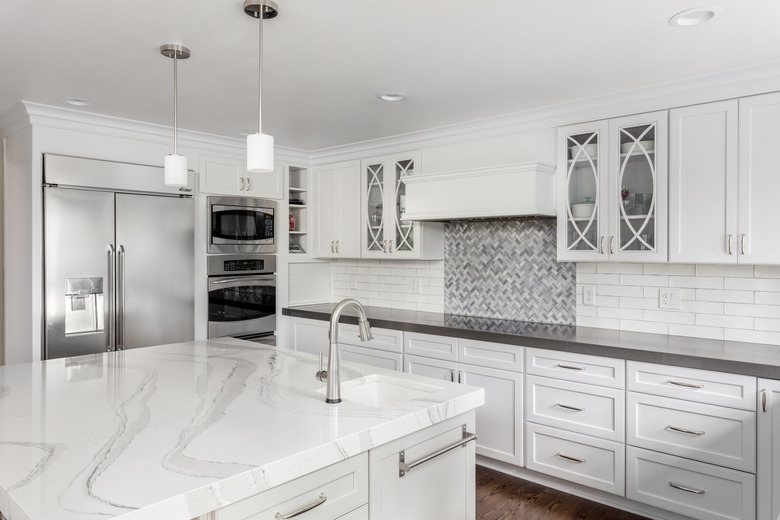How To Remove Paint From A Laminate Cabinet
Painting walls, furniture and cabinets is a quick and affordable way to update an outdated living space or freshen up a drab room. But then you might have to deal with the after effects of working with colorful, liquid paint. Re-doing a space with paint can leave drops or swaths of paint on places that were never intended to be touched by the viscous, colorful substance.
Paint that has been errantly placed on laminate can be removed without harming the gleaming expanse of flooring, siding or countertop. Removing paint from laminate cabinets requires a quick response to fresh paint spills, the right techniques and detergents for dried paint and a steady hand for big dollops of unsightly paint that have found their way to the laminate surface.
Tip
Swipe up errant drops of paint immediately to save time and labor cleaning up dried paint with solvents.
Prepping Laminate for Paint Removal
Prepping Laminate for Paint Removal
The paint may seem like an eyesore, but there is much more happening on the facade of the kitchen or bathroom cabinet than meets the eye. Before you address the globs of dried paint to create a pristine laminate surface, the entire cabinet face needs to be thoroughly cleaned.
Clean Home Guide recommends wiping down and then vacuuming the surface of the laminate before you begin scraping or otherwise removing paint from the cabinets. This will cut down on scrapes and fine scratches on the protective laminate coating that can be made from dirt and debris
Milk Paint on Laminate Cabinets
Milk Paint on Laminate Cabinets
The milk paint technique is highly recommended and can change up an outdated bank of kitchen cabinets in a flash. However, milk paint drops and splashes on cabinets where they are unwanted can be a problem. If possible, wipe up drops of milk paint on laminate cabinets as soon as they occur.
If paint has dried, then it needs a bit of elbow grease and common household cleaners. Milk paint on laminate cabinets can come off with a swath of simple household solvents. Isopropyl alcohol and acetone used for nail polish removal can dissolve crusted, dried paint on laminate, according to Tech Lib.
Always test a small area of the laminate before splashing large pools of a serious solvent, such as rubbing alcohol or nail polish remover, to the affected area. While effective, solvents can tear down the finish of an aged laminate cabinet finish or discolor the laminate finish on kitchen and bathroom cabinets. After applying the solvent, wipe down the area immediately with warm water to remove any of the residue and lingering bits of dried paint.
Removing Laminate Glue from Cabinets
Removing Laminate Glue from Cabinets
Often, tiny globs of laminate glue can find their way onto cabinets. This can go unnoticed until the glue glob's surface becomes covered in grime and dust or creates an aesthetic or structural issue. Removing laminate glue from cabinets in the kitchen or bathroom requires a soft touch and sharp tools.
Use a razor blade to remove dots of laminate glue from the kitchen or bathroom cabinets. Swiftly push the blade under the glob and up. Use work gloves and safety goggles when working with sharp tools in tight areas. Removing laminate glue from cabinets will make the surface problem-free, preserve the cabinet's structural integrity and cut down on future repairs.
